In today's digital landscape, relying solely on last-click attribution can leave Shopify merchants blind to the full customer journey. Shoppers interact with multiple touchpoints—ads, emails, influencers, and organic content—before making a purchase. This guide will walk you through understanding and implementing multi-touch attribution in Shopify, ensuring you capture every interaction and make data-driven decisions in 2025.
What is Shopify's attribution model and the issue?
Shopify Analytics' Marketing Reports feature two attribution models to assess credit for conversion events. The first is Conversion by First touch attribution, which provides all the recognition to the initial touchpoint; while Conversion by Last touch attribution assigns full credit of conversion to its concluding contact point.
Shopify attribution measures conversions based on the last clicked interaction, disregarding any credit to direct channels. This means that it will attribute credit for a conversion to the most recent click and its corresponding keyword, even if prior visits were from people who directly navigated to your eCommerce store.
The problem with this approach is that conversions today are often influenced by multiple touchpoints. This makes it difficult to understand how each touchpoint contributes to the overall customer journey, preventing marketers from optimizing their marketing channels effectively. Furthermore, you need to understand every customer's conversion journey so you can keep on improving your full customer experience. But currently, the data is unavailable.
Why You Need A Independent Attribution Software?
1. Track campaign performance and its ROI across multiple platforms
If you just run your campaign on 1 marketing channel, like Facebook. It's ok to use the original Facebook ads manager to track the conversions.
As your store promote to multiple platforms, an attribution software become improtant to prevent your conversions from double counting by multiple platforms.
In order to maintain a positive marketing ROI, it is crucial to carefully monitor your marketing performance using accurate metrics. Attribution software is an ideal tool for monitoring these metrics across various channels, allowing you to respond quickly and avoid wasting your budget. Wasting budget is one of the top reasons why brands fail, so it is important to stay vigilant and make informed decisions based on accurate data.

2. Understand the customer buying journey
Understanding the customer buying journey is not only crucial for driving awareness, consideration, and conversion, but it is also essential for delivering a great user experience. By gaining insights into how customers navigate through their journey, businesses can tailor their marketing strategies to meet their needs at every stage.
When businesses understand the customer buying process, they can identify pain points, optimize touchpoints, and make informed decisions about where to allocate their marketing budget. This understanding allows them to create a seamless and personalized user experience that ultimately leads to higher conversions and customer satisfaction.

3. Ads platform is unstable now
privacy regulations and technological shifts such as iOS 14 and the phasing out of third-party cookies have drastically hindered ad platforms' tracking capabilities, implementing your own first-party data has become indispensable for accurate attribution.
First-party data offers unparalleled insights into customer behavior by capturing direct interactions with your brand, allowing you to track the entire customer journey without relying on external data sources that are becoming increasingly unreliable.
By leveraging this data, marketers can gain a comprehensive understanding of how each touchpoint contributes to conversions, thereby enabling precise budget allocation and enhanced campaign performance. This approach not only mitigates the data loss associated with third-party tracking limitations but also empowers businesses to deliver more personalized and relevant customer experiences, ultimately driving sustainable growth.
The Difference Between Multi-Touch Attribution and single-touch attribution Models
Multi-touch attribution models assign credit to more than one touchpoint during the buying process. For example, a user may have seen a Facebook ad on social media and then clicked on a paid Google search ad before making a conversion. With multi-touch models, each of those interactions would be assigned some credit for the eventual sale. This is different from single-touch models which only assign credit to the first or last interaction that occurred during the purchase journey.
Types of Multi-Touch Attribution Models
There are lots of models to determine how credit is given to touchpoints. Because in a customer journey, there may be different devices, browsers, campaigns working together. So Shopify merchants need to understand which campaign is the key contributor in the conversions.
1. Linear multi-touch attribution model
The linear attribution model gives equal credit for all touchpoints in a conversion. This is the most basic model which assigns credit to each interaction based on its position in the user's journey, regardless of the impact each touchpoint has.
For example, there are 3 touchpoints before a conversion: Tiktok ads, Tiktok influencer marketing, LinkedIn ads. In a linear model, 3 touchpoints receive 0.33 conversion each.
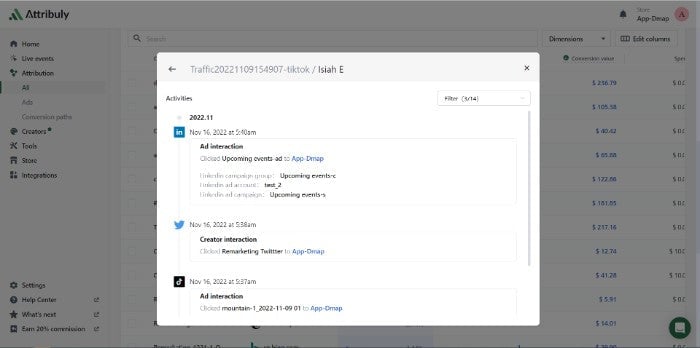
2. U-shape attribution model
The U-shaped multi-touch attribution model is a kind of position-based attribution model. It gives more credit to the first and last touches of conversion while assigning less weight to any touchpoints in between. This model is great for recognizing the search and other channels that typically drive the majority of conversions.
For example, there are 6 touchpoints before a conversion: Facebook ads, Tiktok influencer, email, Reddit social media, Google organic search, and referral. In a U-shaped model, 2 Touchpoints (Facebook ads and Referral site) receive 0.4 conversions each while Tiktok influencer, email, Reddit social media, Google organic search receive 0.05 each.
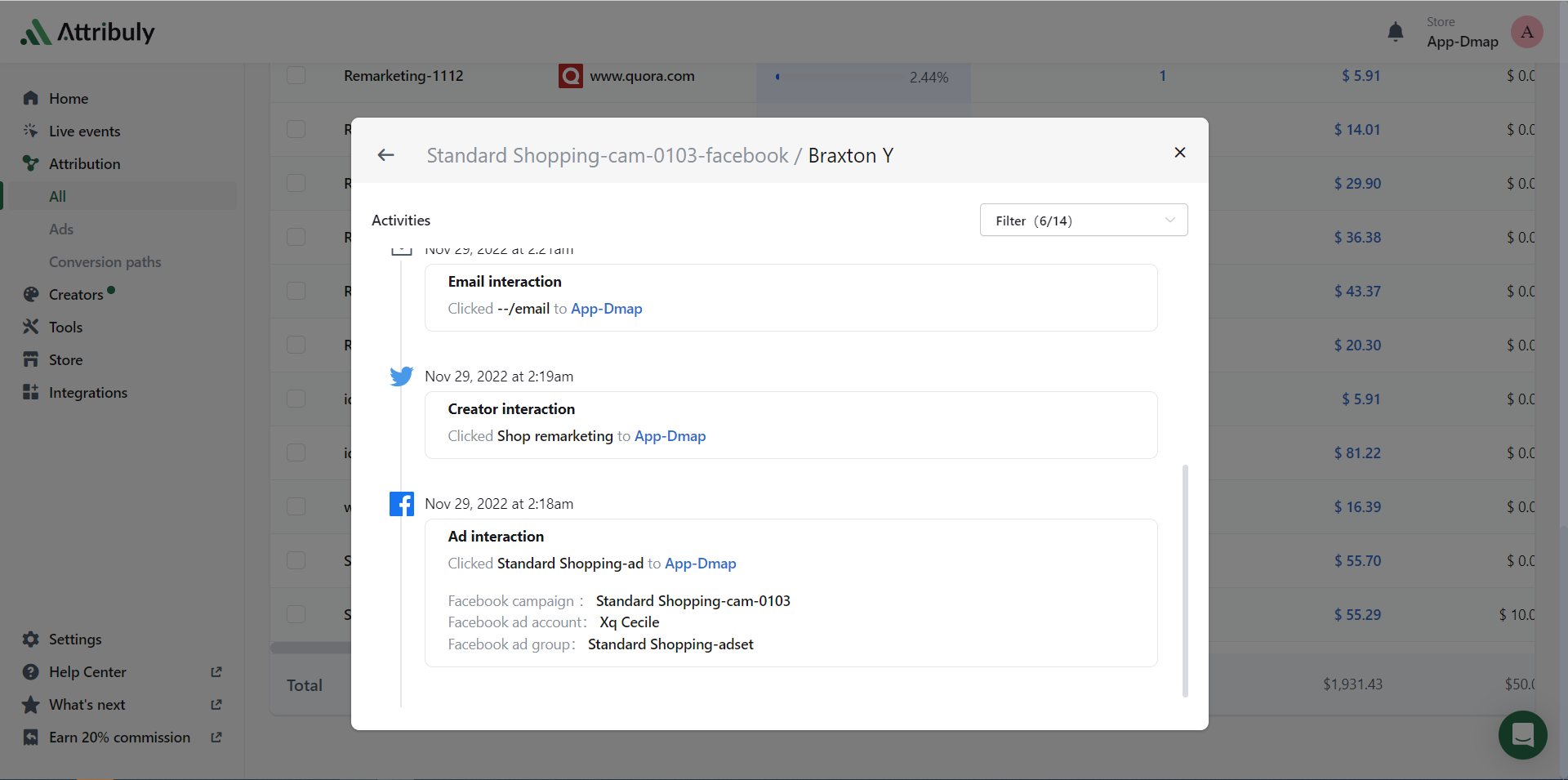
3. Time Decay Attribution Model
The time Decay multi-touch attribution model gives more weight to touchpoints that are closer to the conversion. It assigns most of the credit to the touchpoint nearest to a conversion and lessens as you go further away from the conversion. This helps give marketers insight into how quickly customers convert after being exposed to their marketing message.
All above models belong to rules-based multi-touch attribution models, meaning the weight is pre-defined. There are also models that adopt machine learning.
Algorithmic or data-driven multi-touch attribution models
Rule-based multi-touch attribution models assign credit to touchpoints by using pre-defined rules, algorithmic or data-driven multi-touch attribution models use data science and machine learning to determine the weight of each touchpoint. These models can be more accurate in assigning weights as they are based on actual user behavior.
Which attribution model you should choose?
The attribution model you choose has a significant impact on how you allocate your budget and is closely tied to your growth strategy. If your goal is to maximize conversions, the last click attribution model is ideal as it attributes all the conversions to the last touchpoint. However, this approach may pose challenges for achieving a high growth rate due to limited investment in the awareness and consideration stages.
Alternatively, if you have a growth mindset and are focused on expanding your business, the First click model may be the ideal choice for you.
Attribuly chooses Linear as the default attribution model since it's a balanced choice.
Benefits of Multi-Touch Attribution
Multi-touch attribution models are essential for eCommerce marketers who want to understand and optimize the full customer journey. Unlike single-touch models, which oversimplify by giving all credit to one interaction, multi-touch models reveal how each channel contributes to conversions.
By mapping out each touchpoint—from Facebook ads and influencer campaigns to email and organic traffic—marketers can allocate budgets more effectively, shorten sales cycles, and increase overall ROAS (Return on Ad Spend). This insight helps prioritize high-impact campaigns and reduce wasted spend on underperforming channels.
Understanding the customer journey also leads to better user experiences. When you know where your customers came from and what persuaded them to buy, you can tailor messaging by stage and channel. As Alan from TexTale puts it:
"Understanding how my customers interact with Google, Facebook, and influencers is key to knowing what works."
In an age where people are actively tuning out generic marketing, using data-driven attribution is the only way to meet customer expectations and grow sustainably.
What is multi-touch attribution vs marketing mix modeling (MMM)
Multi-touch attribution and marketing mix modeling (MMM) are two distinct yet related approaches to measuring the effectiveness of different channels, campaigns, and ad placements.
While both methods can help marketers understand how their efforts contribute to conversions, there are some key differences between them that should be taken into consideration when devising an overall strategy.
Multi-touch attribution models assign credit to more than one touchpoint during the buying process while MMM looks at a variety of factors including channels, campaigns, pricing strategies and other variables in order to determine which ones have had the most impact on sales or leads.
By understanding these differences between multi-touch attribution and marketing mix modeling (MMM), marketers can make better decisions about where they should allocate resources for maximum return on investment (ROI).
The attribution challenges Shopify merchants are facing
1. Lack of accurate data
The privacy policy, ad blockers, IOS 14 updates are changing the way merchants collect customer data. Attribution software can't work without accurate data. For Shopify merchants, The new Shopify web pixel should be the best option to collect data.
For WooCommerce and other platforms, try to upgrade tracking with first-party cookie and collect as many as first-party data as possible.
2. More and more marketing channels
Are you exploring the potential of new marketing channels like TikTok and Facebook Shop for your store? As you venture into multiple channels for promotion, you may encounter the complexities of attribution.
How to get started with multi-touch attribution
We have seen some high-growth brands build their flywheel based on 3 points:
1, Experiment campaigns based on combination of ( Creatives, copies, audiences)
2, Get multi-touch attribution analysis and single customer level conversion journey.
3, Scale the hign performance campaigns and turn off the bad one.The attribution report is critical, since brands need this data to make decisions of campaign optimization. All the tactics can't run well without great data.
Step #1: Deploy Marketing Analytics Software
There are lot of marketing attribution apps for Shopify merchants. Some best matches should have deep integration with Shopify to make sure you can easily deploy.
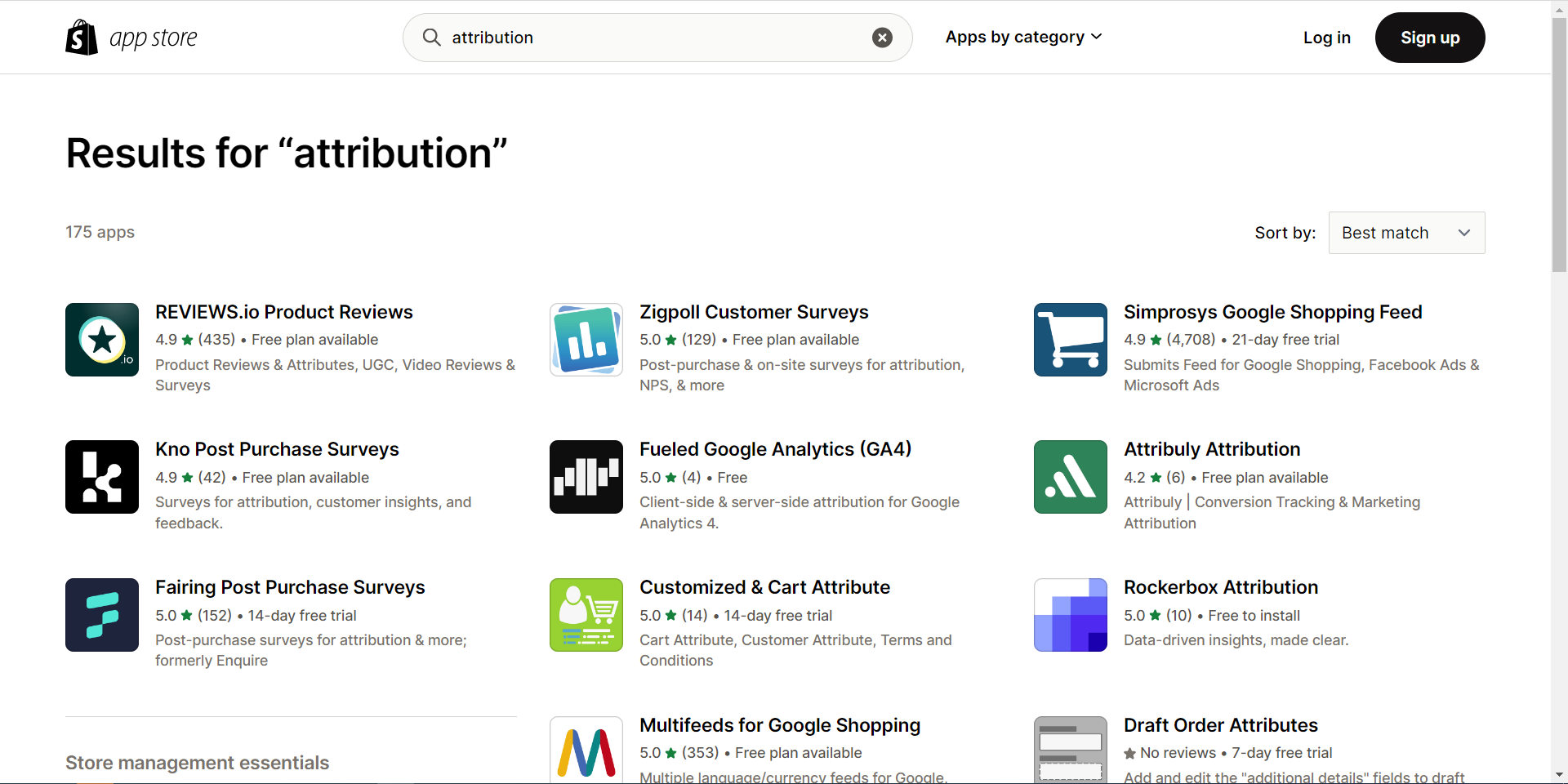
Step #2: Capture your marketing data
To get customer behaviors raw data, you need to insert tracking snippets. These snippets track most customer conversion events such as page view, add to cart, checkout start, payment info and finish purchase.
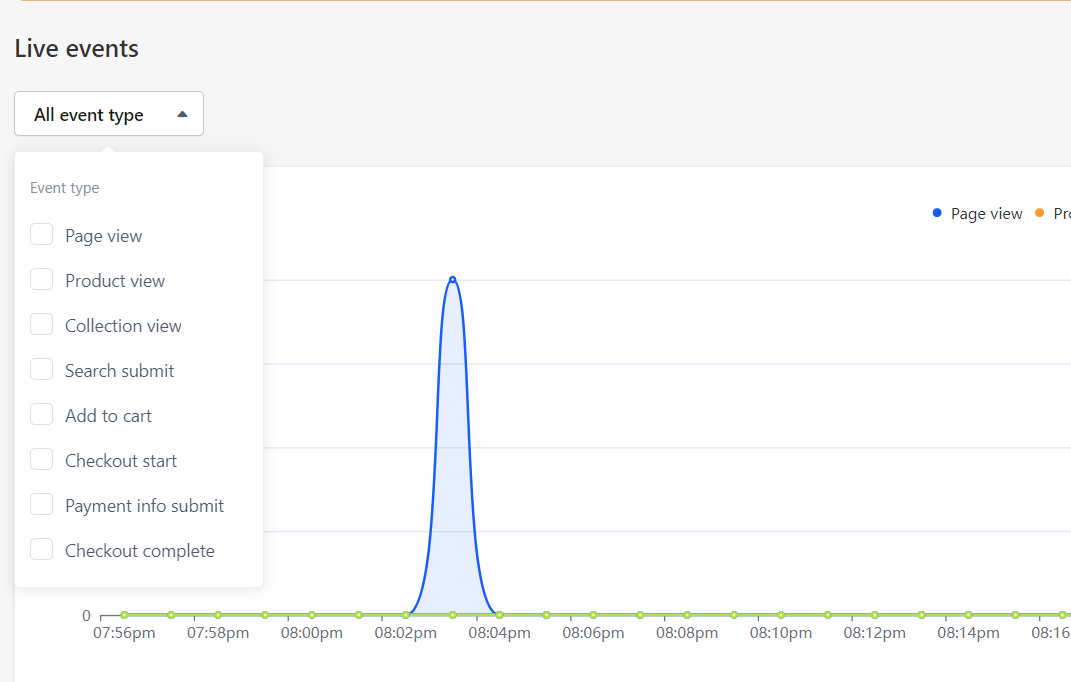
Managing tracking snippets can be complicated. Attribuly has released a code-free solution, which integrates with Shopify pixels & customer events. This future-oriented solution can save lot of work for browser side tag management.
Furthermore, you may also get conversion events from Shopify server-side tracking. Because some orders could not be triggered at browser-side. For example, the recurring orders.
Step #3: marketing channels integration
To understand detailed customer sources and ROAS, you need to connect different channels.
So by integrating your first-party data including historical data, you get an accurate insight of blended or single ad performance. This important data is key to make sure you don't spend money to the wrong campaigns.
You can also connect to klaviyo, uppromote and all your touch points.
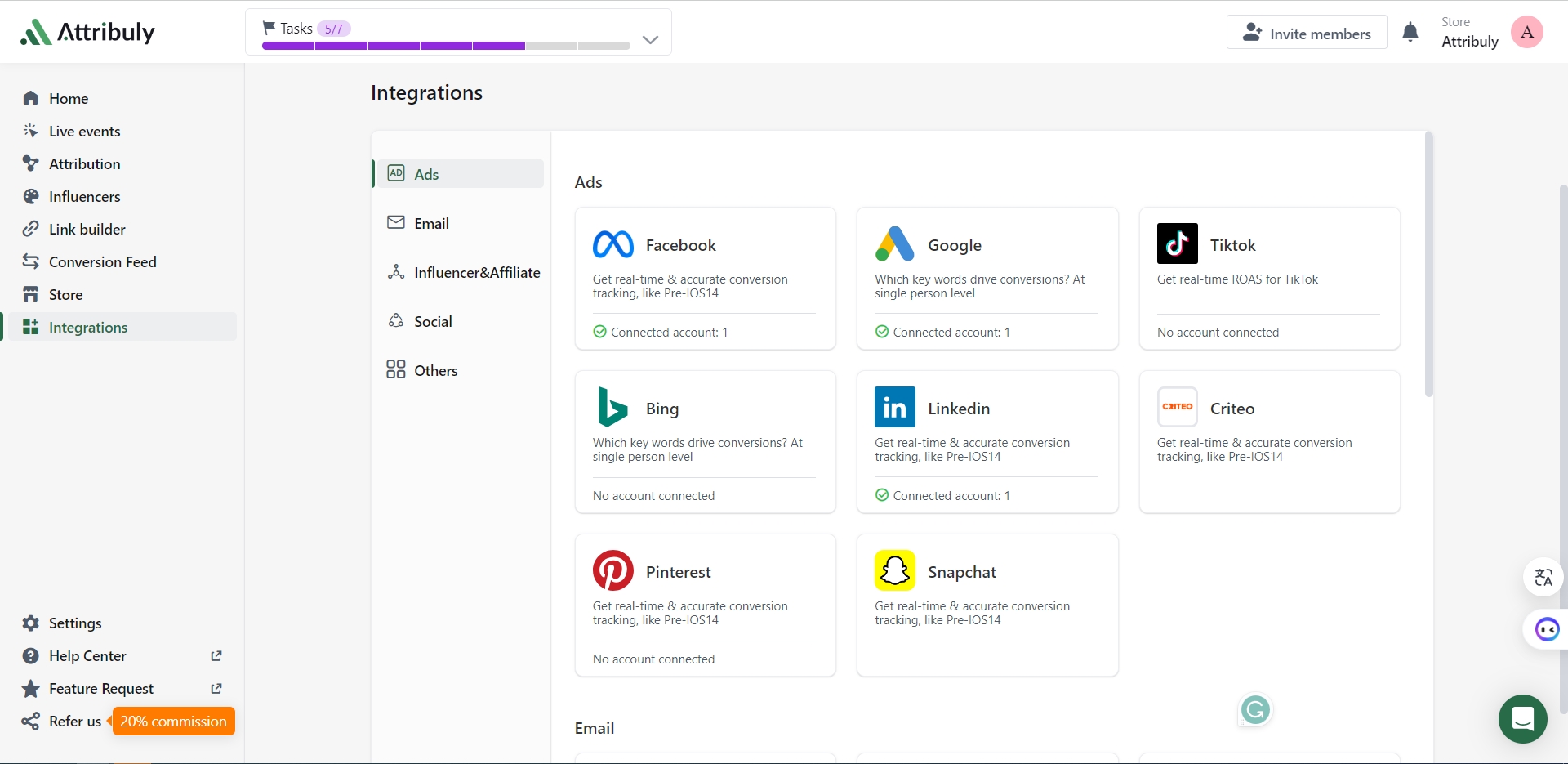
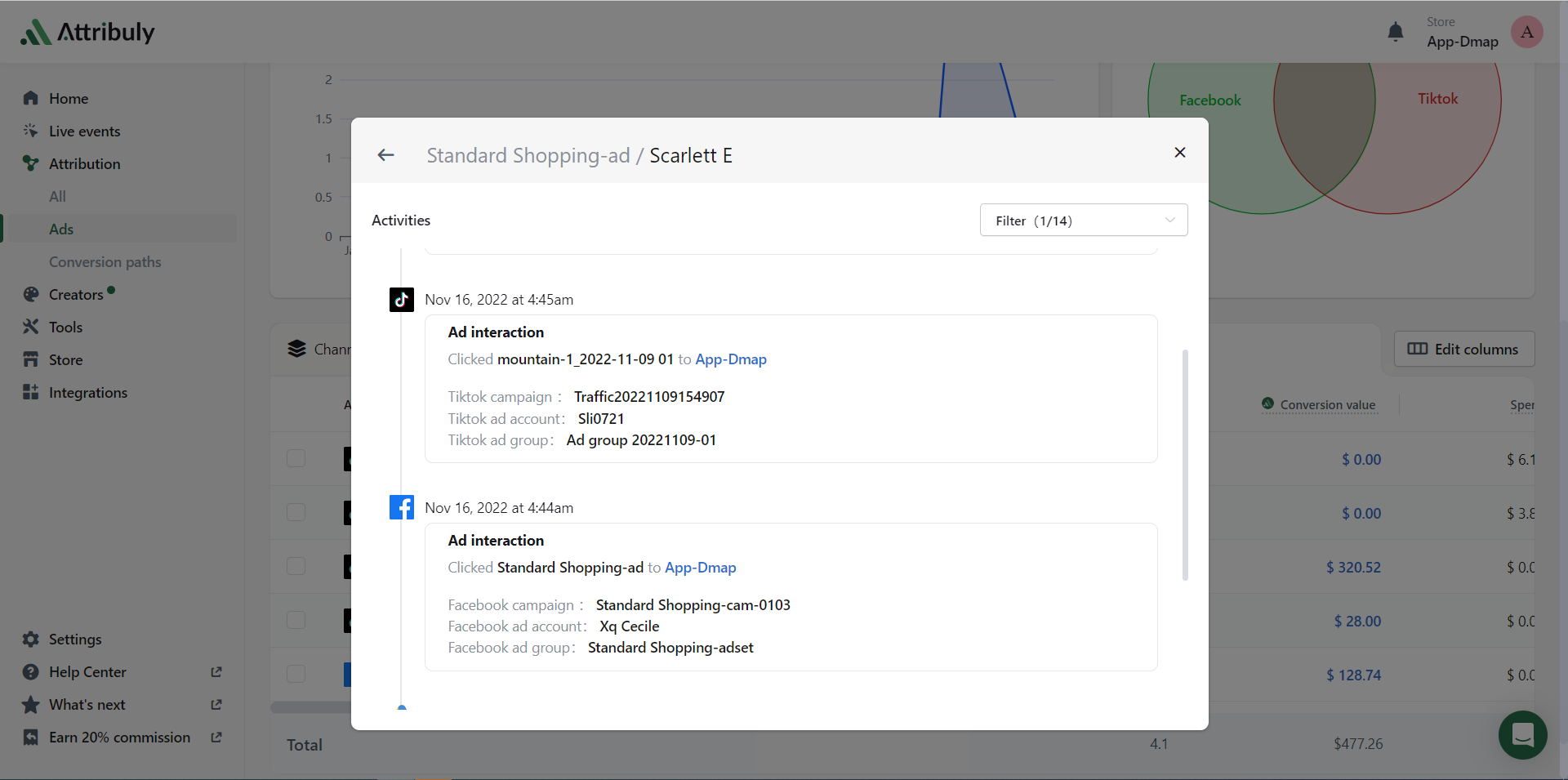
Step #4: Set up conversion goals
Setting up a conversion goal is an important step when setting up attribution analytics for Shopify e-commerce businesses. A conversion goal allows marketers to track the customer journey and understand how their marketing campaigns are contributing to sales or leads. It can also help them identify which channels, campaigns, and ad placements are most effective in driving conversions.
Most brands set up goals for different products at different stages. You will find this setup easy if there is integration with Shopify. What you need to do is just select the event type and products you want to put into the goal. Then the software will automatically finish the rest.
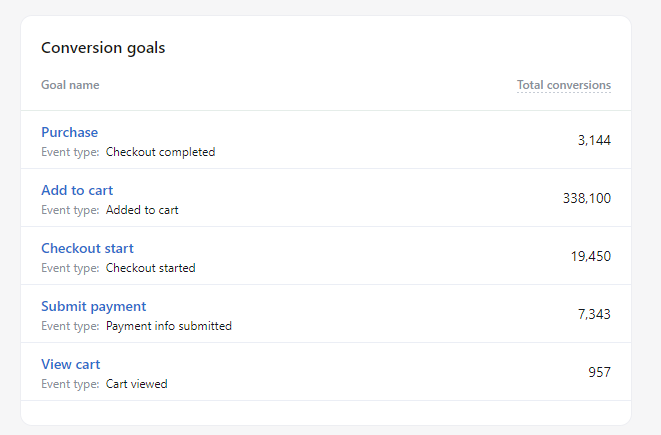
Step #5: test different attribution models
For advertisement, you can view a blended ROAS across marketing platforms, to view overall return. Or dive into single ad ROAS to find the best-performing campaigns. The ROAS will be changed according to multiple models you select.
You may want to check every conversion's customer journey. So you get a rich insight into the customer portrait. With some external customer information, such as social information. You will have a clear understanding of your audience's portrait.
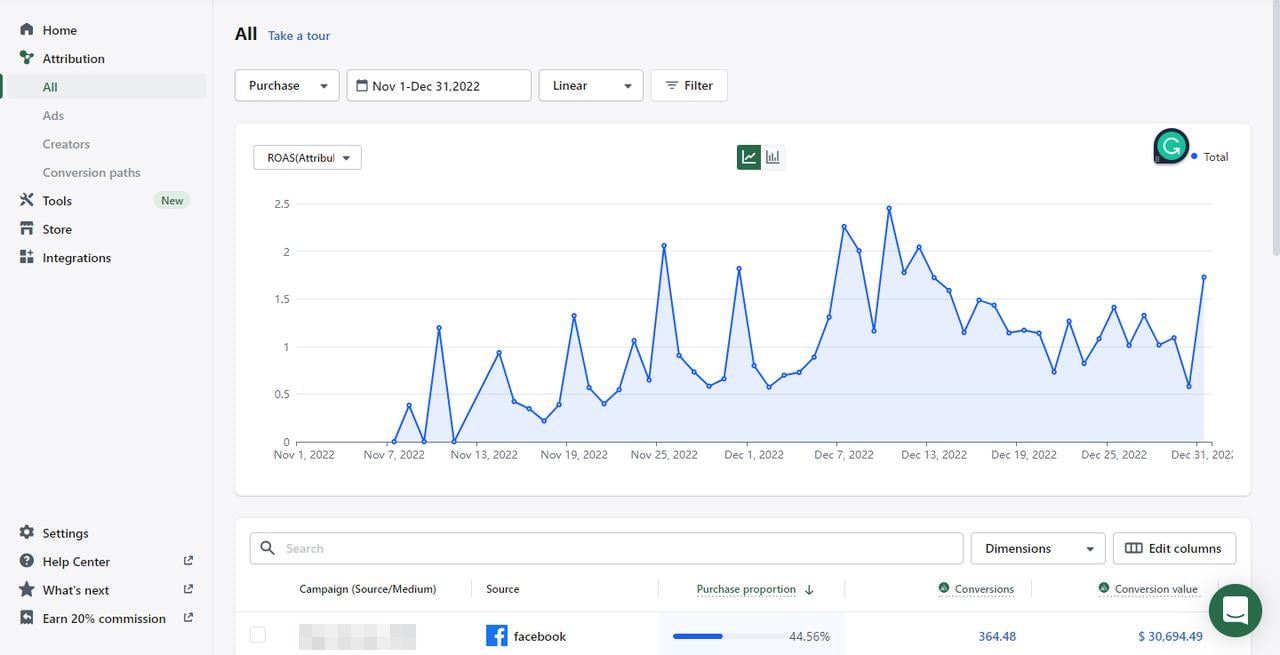
You may have a lot of campaigns in testing, so you will scale the best-performing one. In the long run you invest money in all the performing campaigns so your ROAS keeps in a stable and high level.
Step #6: check conversion paths
Conversion paths give you a bird view on some most important routes that your customer convert. So you may invest more with the highest conversion rate, and conversion value. Aware that using different models with result differently.
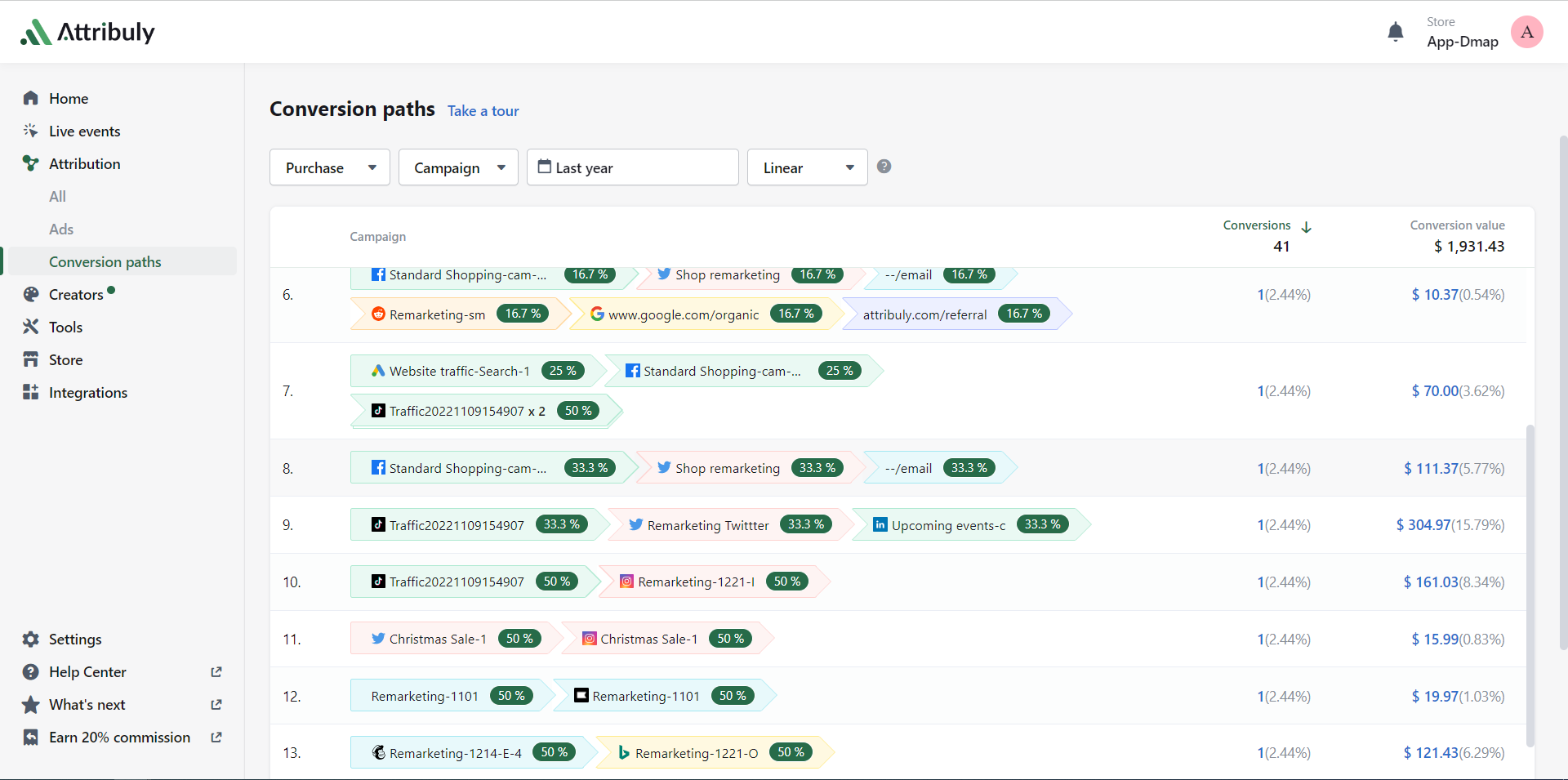
Conclusion
Multi-touch attribution tools are invaluable for Shopify merchants who are looking to maximize their ROI in the crowded e-commerce space. By understanding how their customers interact with various channels and campaigns throughout the customer journey, marketers can make more informed decisions about how to allocate marketing investments and resources. Additionally, by carefully evaluating their data and experimenting with different models, they can further refine their strategies and ensure that they are getting the most out of every dollar spent. With the right approach, multi-touch attribution can be an effective way for Shopify merchants to understand their customers’ behavior and maximize their marketing ROI.
